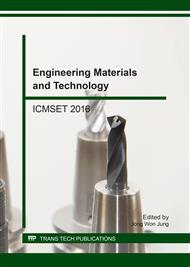[1]
M. Z. Li, K. Nakamura, S. Watanabe, K. Sugawara, Study of the basic principles (1st report: research on multi-point forming for sheet metal), Proceedings of the Japanese Spring Conference for Technology of Plasticity, 1992, 519-522 (in Japanese).
Google Scholar
[2]
M. Z. Li, Y. H. Liu, S. Z. Su, G. Q. Li, Multi-point forming: a flexible manufacturing method for a 3D surface sheet, J. Mater. Process. Technol. 87(1-3) (1999) 277-280.
DOI: 10.1016/s0924-0136(98)00364-1
Google Scholar
[3]
C. G. Liu, M. Z. Li, W. Z. Fu, Principles and apparatus of multi-point forming for sheet metal, Int. J. Adv. Manuf. Technol. 35(11) (2008) 1227-1233.
DOI: 10.1007/s00170-006-0802-1
Google Scholar
[4]
Y. S. Deng, Y. Yao, S. H. Wang, Numerical Analysis for the Multi-Point Stretch Forming Process of Aircraft Skin Panel, Appl. Mech. Mater. 109 (2011) 504-508.
DOI: 10.4028/www.scientific.net/amm.109.504
Google Scholar
[5]
F. X. Tan, M. Z. Li, Z. R. Qian, et al. Numerical simulation on process of multi-point forming for titanium alloy cranial prosthesis, J. Jilin Univ. (Engineering and Technology Edition), 6 (2006) 851-855 (in Chinese).
Google Scholar
[6]
C. G. Liu, X. G. Zhang, S. L. Zhang, X. Z. Liu, Stretching and trimming of high-speed train panels using multi-point tooling, Mater. Res. Innov. 19(S5) (2015) S5-393-S5-397.
DOI: 10.1179/1432891714z.0000000001117
Google Scholar
[7]
M. Z. Li, X. J. Cui, Y. S. Deng, et al. The Current Status and Developing Tendency of Multi- point Forming Technique, China Metal forming Equipment Manuf. Technol. 5 (2007) 15 (in Chinese).
Google Scholar
[8]
Z. Y. Cai, M. Z. Li, Multi-point forming of three- dimensional sheet metal and the control of the forming process, Int. J. Press. Vessel. Piping. 79(4) (2002) 289-296.
DOI: 10.1016/s0308-0161(02)00017-0
Google Scholar
[9]
W. Liu, S. Jia, C. M. Zhang, M. Z. Li, Generation and suppression of local severe plastic deformation in sectional multi-point forming, Int. J. Adv. Manuf. Technol. 32(32) (2007) 705-710.
DOI: 10.1007/s00170-005-0390-5
Google Scholar
[10]
C. G. Liu, Z. Y. Cai, M. Z. Li, Dimple formation and its elimination in multi-point forming for sheet metal, J. Univ. (Engineering and Technology Edition), 1 (2004) 91 (in Chinese).
Google Scholar
[11]
X. D. Chen, Z. Y. Cai, M. Z. Li, Numerical simulation of wrinkling in multi-point forming for sheet metal without blank holder, Trans. Chin. Soc. Agric. Mach. 36 (2005) 330-333 (in Chinese).
Google Scholar
[12]
J. J. Chen, M. Z. Li, W. Liu, C. T. Sectional multipoint forming technology for large-size sheet metal, Int. J. Adv. Manuf. Technol. 25(9-10) (2005) 935-939.
DOI: 10.1007/s00170-003-1924-3
Google Scholar
[13]
G. Wei, R. H. Wagoner, Die design method for sheet springback, Int. J. Mech. Sci. 46(7) (2004) 1097-1113.
Google Scholar
[14]
B. Davoodi, B. Zareh-Desari, Assessment of forming parameters influencing spring-back in multi-point forming process: A comprehensive experimental and numerical study, Mater. Des. 59(6) (2014) 103-114.
DOI: 10.1016/j.matdes.2014.02.043
Google Scholar
[15]
Q. F. Zhang, Z. Y. Cai, Y. Zhang, M. Z. Li, Springback compensation method for doubly curved plate in multi-point forming, Mater. Des. 47(9) (2013) 377-385.
DOI: 10.1016/j.matdes.2012.12.005
Google Scholar
[16]
Z. R. Qian, M. Z. Li, F. X. Tan, G. Sun, Numerical simulation on the process of sphere surface multi-step multi-point forming, J. Jilin Univ. (Engineering and Technology Edition), 02 (2007) 338-342 (in Chinese).
Google Scholar


